|
We Update Daily!
 Custom Search Custom Search
Chris S. Kenoyer. Owner
MMJ Patient, Medical Activist, Online Patients Advocate,
Online MMJ News Journalist
My Personal Medical Bio
Follow Us Now On Twitter
@MedicalMMJMan
Or Follow Us Now
On Facebook
Email Us Here
olpwebs@yahoo.com
Or Email Us Securely Here
MedicalMMJMan@countermail.com
NEW 100% Encrypted Email Server
OLP’s Free MMJ News EList
Get The Latest In MMJ News
All Press Contact Info For Us!
Is CBD? A Possible Cure For
Breast Cancer..? And All The Other
Many Forms & Types Of Cancer..?
Learn More About " CBD" Here
***************************
Advertise Here On OnlinePot
Rates As Low As $50 a Year
24/7 – 365 Days A Year Of Sales!
***********************************
Website Navigational Links
Main Start Page 2
**************************
Latest Marijuana News Reports
*********************************
Parody’s Cartoons US
Government Grown Pot,
Term Papers, School
Reports, & Thesis’s On
Marijuana & Cannabis
*********************************
Amsterdam A to Z
********************************
Canadian Marijuana Websites
*******************************
Church’s & Pot Cannabis
*****************************
Co-Ops, Clinics, Dispensary’s
*****************************
Marijuana Doctors & Clinics
****************************
Pot Cooking Recipes
****************************
Drug Testing A To Z
***************************
Pot Games
****************************
Pot Songs Video’s
****************************
100’s Of Grow Guides
***************************
Hash A- Z
***************************
Cannabis Legal Info, Drug
Lawyers, State, Federal Laws,
State & Supreme Court Rulings
**********************
POW’s Of The MMJ War!
*****************************
Other Marijuana Websites
Websites Link Exchange!
****************************
Medical Marijuana Studies,
Research Report’s, Medical
Cannabis Clinic Study’s
****************************
Parody’s & Cartoons
When We All Need A Good Laugh!
****************************
Avoiding Online MOM Scammers
Newly Re-Updated Info!
*****************************
The Politics Of Contraband
Medical Marijuana In The Mail?
******************************
The Hall Of Shame Section
The Online MOM Scammers
*****************************
Online MOM Providers Ads
****************************
Politicians & Voters Rights
****************************
Medical Marijuana, Strains
****************************
The OG Marijuana Strain Guide
****************************
800+ FAQ Growing Questions
****************************
Patients Spiritual Guidance,
Free Online Crisis Help Center
****************************
Online Marijuana Seed Banks
****************************
Maximum Security Section
Just Updated!
*****************************
Traveling Tips, Guides, B & B’s
****************************
Vaporizers A To Z
*****************************
Online Pot Video’s & Movies
**********************************************
Please Visit Our Sister Websites!
Maine Patients Coalition.org
Reefer Madness Teaching
Museum.org
Listen Right Here Online!
To Original 1930-1950’s
Reefer Madness Propaganda
Radio Shows And Programs
Before TV There Were
"Radio Stars"
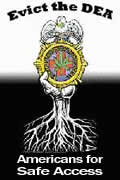


*********************************
Legal Disclaimer
Guest Book
Translate Text or Web Page Go To:
Language Tools Google Translations
Article Submissions & News
Reports Are Always Gladly
Accepted Here.

1999-2013 Copyright ?
All Rights Reserved.
No part of this site maybe used or
reproduced in whole or in part
without the written consent of the
Copyright Owner
www.onlinepot.org
OnlinePot assumes no legal liability for any products, or information or
news posted, services offered, Or
any contests or give away’s offered.
|
|
The Addict and the Law
By Alfred R. Lindesmith
Washington Post, 1961
Introduction | 1 | 2 | 3 | 4 | 5 | 6 | 7 | 8 | 9 | 10
CHAPTER 4 THE NUMBER OF ADDICTS AND RECRUITMENT PATTERNS
The number of drug addicts in the United States has always been an essentially unknown quantity. Before 1914, when addiction was not a criminal matter, a number of enumerations within states or local communities were made and the results applied to the United States as a whole. The estimates derived by these and other methods covered a very wide range, from one hundred thousand or so to more than a million, All of them were admittedly highly unreliable and they do not justify the confident
assertions now being made concerning the extent of addiction ill this country in earlier periods. Bad is they were the pre- 914 estimates were not as unreliable as those made after that date and those that are currently circulated.
After 1914, when addiction became a criminal act, counting addicts posed much the same difficulties that would be encountered in a census of racketeers. The only relevant figures available on a national basis are those pertaining to arrests, prosecutions, convictions, and commitments, and these are far from being complete or reliable, The number of addicts arrested annually is not reported, arrests for narcotics law violations are fully reported only on the federal level, and the number of addicts serving time in penal establishments is unknown, Since the range of estimates of the addicted population at present is at least as great as it was before 1914, one can make out a case for any trend one chooses by judiciously selecting the estimates.
Federal narcotics officials have vigorously promoted the view that the number of addicts has declined drastically over the years
in this country. From a total of about 200,000 in 1914 the number of addicts allegedly diminished to about 49,000 or 60,000 during
the time of World War 11. The former figure Of 48,000 was described as an irreducible minimum. In the Bureau’s well-known and
well-publicized ski-jump curve, discussed later in this chapter, the World War 11 minimum number of addicts is indicated as about
20,000 although the usual estimates given are 48,000 or 60,000 After the Bureau began its count of addicts (to be discussed later), it abandoned its former estimates and began to utilize numbers generated by its survey as an indication, not of the total addicted population, but of “active addicts”- i.e., persons actually using drugs illegally and reported as such to the Bureau. However, the word “active” is sometimes left out when this total is given, thus enhancing the tendency to view the number, not as a partial count, but as a comprehensive estimate. Thus the United States report to the United Nations Commission on Narcotic Drugs for 1960 states: “There were 44,906 addicts in the United States on the 31 December 1960 …. 1
During the hearings held in 1955 in various sections of the country by the Senate subcommittee chaired by Price Daniel and the
House subcommittee under Hale Boggs, the members of the subcommittees were given the 60,000 estimate, which they seemed to accept. As they moved from one part of the country to another they were given estimates by various local officials concerning
numbers of addicts in given counties, states, or cities. These estimates also appear to have been accepted. New York authorities estimated 20,000 California 20,000, Illinois 10,000 and Ohio 15,000, making a total Of 65,000 drugs users in only four states. These local estimates were based upon local surveys or upon police files. The Ohio estimate was the result of a survey conducted in that state with the assistance of the Federal Bureau of Narcotics. The California estimate was contained in the report of a Citizen’s Advisory Committee to the Attorney General in 1953. It stated:
It is known that we have in our State medical files some 32,000 persons who are legally using narcotics medicinalIy, although a certain percentage of them may be using it illegally because they are going to several doctors concurrently. The State Criminal files reflect that there are approximately 10,000 additional traffickers or users of narcotics in California. It is believed that 10,000 represents approximately one-half of the total illegal addicts in this State. Our estimated total, therefore, would be 32,000 medical or legal users and probably 20,000 illegal, 2 total Of 52,000 persons.2
California officials and police officers generally agreed that addiction in that state was probably increasing about as fast as the population. Disregarding the alleged 32,000 legal users, most of whom were probably not addicts (if the figure itself is not in error), it is impossible to take the 60,000 estimate for the nation as a whole seriously in view of reports from individual states and cities. It is of interest to observe that some twenty years earlier in 1931 3 State Narcotic Committee estimated that there were about 3,000 addicts in California.3
Figures on narcotics from the state of California are of unusual importance because the state has an exemplary centralized system
of collecting and processing the relevant data.4 A Division of Narcotic Enforcement within the State Department of Justice provides narcotic prescription order forms in triplicate to physicians. it is required that one of the three copies of all narcotic prescriptions be forwarded to the state office, where they are processed. Since these order forms are serially numbered this procedure enables state enforcement authorities to keep a close check on all prescriptions for narcotics and on the persons who receive them.
In addition, the Bureau of Criminal Statistics of the California Department of Justice has recently begun to issue comprehensive
reports on arrests and prosecutions for narcotics violations within the state. Both misdemeanors and felonies are covered. This Bureau reported that in 1960 some 1 6,000 persons were arrested in that state for narcotic offenses and that arrest rates for such offenses had increased about 1 2 per cent in each of the preceding two years. After 1960 arrest rates for offenses involving heroin or equivalent drugs showed a tendency to decline, as did arrests for marihuana violations. This decline was counterbalanced by very substantial increases in arrests for dangerous drugs other than opiates and marihuana, such as the barbiturates and amphetamines. It is impossible to know. from presently available figures, how to account for the decline in heroin type arrests. It is possible that the decline may be due to an increase in the number of addicts in prison or that addicts are leaving the state. It is assuredly much too soon to say that the problem in California is on the wane.
There are obviously very large gaps in the estimates of the extent of the narcotics problem provided by the Bureau. A comprehensive view ought to allow for the following: ( 1 ) illegal addicts known to the police by reason of violation of narcotics laws; (2) illegal addicts known to the police through violation of other criminal laws; (3) illegal addicts not known to the police; (4) addicts
securing legal drugs from doctors; and (5) incarcerated users. As we will indicate later in this chapter, the Bureau’s estimates seem to consider primarily only the first of these categories and possibly some of the second. The others are almost entirely disregarded. Earlier estimates used as the basis of comparison invariably tried to cake all categories into account.
A source upon which considerable reliance has been placed in determining the trend of addiction in this country has been the Army rejection rate of draftees on the grounds of addiction. During World War 1, 3,284 persons from 2 total Of 3,500,000 draftees were rejected because of addiction, or approximately one out of 1,000 During World War II the rejection rate for addiction has been given as one in 10,000 by Mr. Anslinger on the authority of a letter to him from Major Harold F. Dorn, Director, Medical Statistics Division, Army Service Forces, dated September 28, 1945.6
Mr. Anslinger applies these rates to the general population to obtain his estimates and to establish trends, but this is not correct procedure. It is known that the incidence of addiction is highest among young men of approximately military age and that it drops off rapidly among older groups. Also there are many more male than female users and there are almost no addicts below the age of fifteen years. According to Lawrence Kolb and A. G. Du Mez of the Public Health Service, if allowance is made for these facts in applying the Army findings to the general population the result is an estimated total of from 1 0,000 to 1 5,000 addicts during the first World War.7 For the period of World War 11 the number would be considerably smaller. Obviously there is something drastically wrong with this method of estimation, and it was rejected as worthless by Kolb and Du Mez.
Even if the Army figures were to yield reasonable totals when applied to the general population, there are other considerations
which would make them suspect. For example, during the second World War, punitive anti narcotic legislation had been enforced
for more than thirty years; at the time of the first World War it had just been enacted and had hardly begun to be enforced. During the second World War it was Army policy to reject (classify as 4-F) persons who had been convicted of narcotic and other offenses, on the grounds of criminal record rather than addiction per se. Furthermore, the general climate of opinion concerning addiction was much harsher in 1941 than it was in 19 16 and the motives for concealment and covering up were enormously increased. In order to know exactly how factors of this kind may have operated during the two war periods it would be necessary to know much more than is now known about the rejection of draftees during both wars It is clear, however, that (a) neither of the rates is of any value as an indication of the number of addicts in the general population, and (b) the two rates are not comparable with each other.
THE SKI-JUMP CURVE
In an appearance before the Price Daniel Senate subcommittee, in 1955, Mr. Anslinger submitted a prepared statement in which he said:
Before the passage of national control legislation fin 19141 there was one addict in every 400 persons in the United States. By World War I this incidence had been reduced to about 1 in every 1,500 persons, and by World War 11 the incidence was found to be roughly 1 in 10,000 rejected for military service because Of addiction. At this time the narcotic traffic in the United Stares was probably at the lowest ebb since the enactment of Federal legislation to control narcotics. Following World War II and the resumption of shipping there has been an influx of heroin from the Middle East and European countries…. The total number of addicts in the United States today is estimated at between 50,000 and 60,000 or an incidence of about 1 in 3,000 of the population.8
This version of the history of the drug problem has been embodied in what has been called the “ski-jump curve,” which is reproduced here:
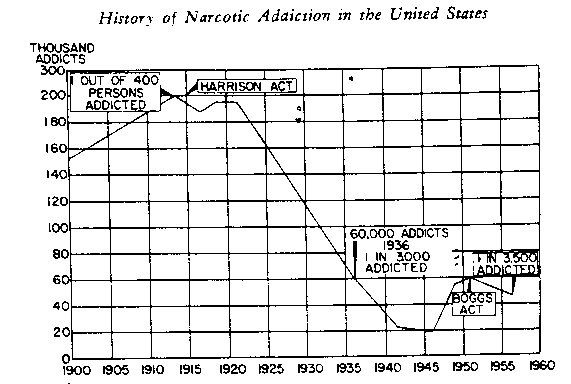
On the face of it this is a highly improbable curve. It suggests, for example, without making any allowance for the appearance of new addicts, that about 42,000 addicts vanished between 1914 and 1925, about 96,000 between 1925 and 1935, and approximately 42,000 between 193 5 and 1945. When new and younger addicts are not being recruited in sufficient numbers to replace older addicts who die Or quit the habit, it necessarily follows that the average age of the addicted population must increase. However, it is well known that between 19 15 and 194 5 the average age of known addicts declined considerably, and this demonstrates that we must assume a constant stream of new addicts being added each year. Bureau spokesmen have repeatedly said that each addict creates four new addicts during his career, but if this were true the addicted population would have had to increase geometrically. Additional difficulties arise with the curve if one tries to take into account the fact that in 19 15 women addicts outnumbered men about three to two and whites outnumbered Negroes around nine to one,
whereas in 1945 male addicts outnumbered females about 5 or 6 to one and whites outnumbered Negroes only about 3 to I – From considerations of this sort alone, it is evident that the Bureau’s ski jump curve is mainly a fantasy, and has little relation to reality.
Tables 1 and 2 and the chart based upon them indicate that the statistical data available in the United States do not support the Bureau’s interpretation of the history of the problem and raise the question whether there are in existence such supporting figures.
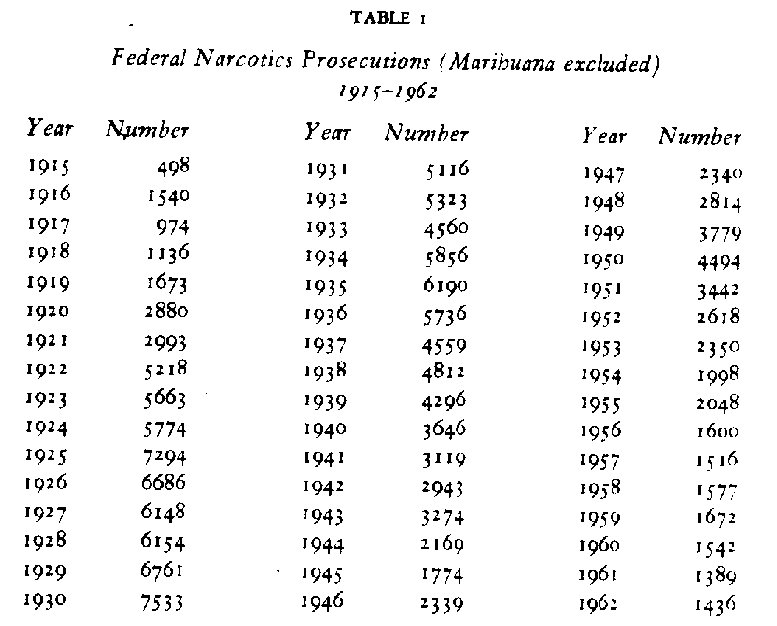
Sources: Annual Reports of the Commissioner of Internal Revenue, 1915-1926; Annual Reports of the Commissioner of Prohibition, 1927-1930 Annual Reports of the Federal Bureau of Narcotics, “Traffic in Opium and Other Dangerous Drugs,” 1931-1962 The description of these totals has varied but they are believed to represent approximately the number of persons charged with criminal violations. Had marihuana cases been included in these figures after 1937, when the marihuana Tax Stamp Act was passed, there would have been no appreciable alteration of the trend, for the number of such cases is small.
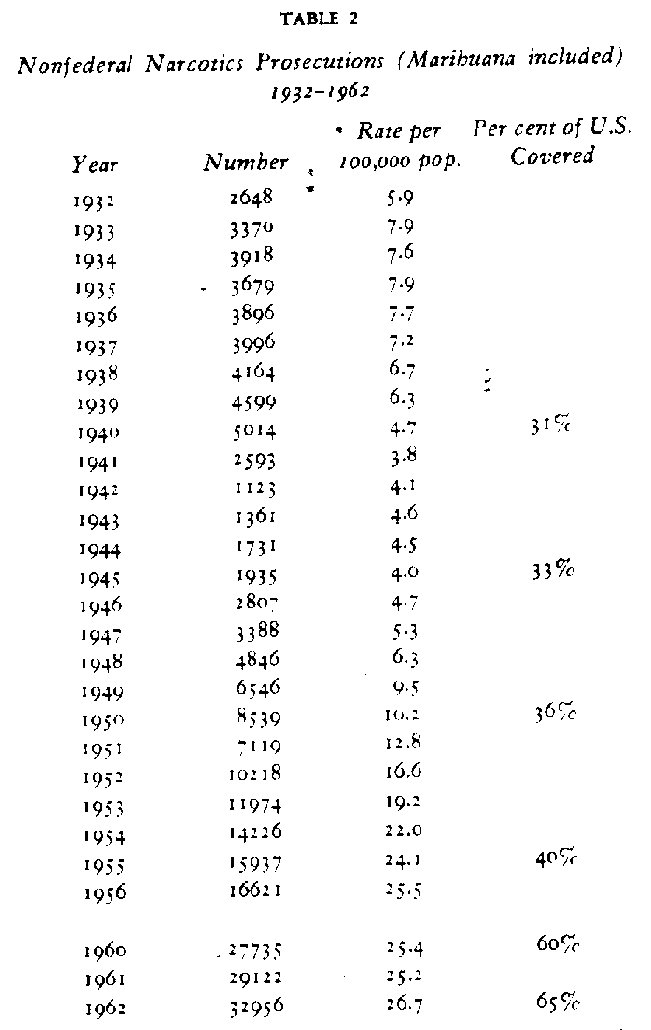
Source: Uniform Crime Reports, Federal Bureau of Investigation, Washington D.C. Comparable figures are not available for 1957 -59 The totals represent “persons held for prosecution.” Various changes in the reporting system and methods of calculation make it extremely hazardous to regard these data as anything more than crude approximations. Reports issued by the F.B.N. indicate that approximately 10 to 15 per cent of these totals are marihuana cases. See Daniel Subcommittee Hearings, Exhibit 8, pp. 272-275.
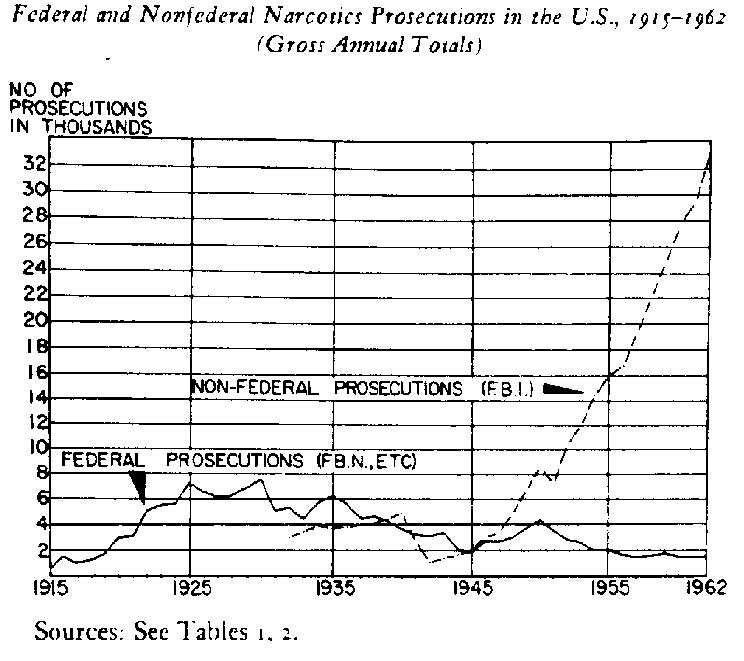
In interpreting the trends indicated by the figures it must be remembered that while the reports on federal prosecutions are complete and cover the entire nation, those on nonfederal prosecutions are very incomplete and cover less than one-half of the country except in the years beginning with 960. Neither the federal nor the nonfederal figures include addicts prosecuted for other than violations of narcotic laws. The sharp rise in the nonfederal totals after 1945 was no doubt influenced to an indeterminate extent by such factors as: ( 1 ) improved reporting, (2.) increased numbers of police assigned to narcotics enforcement, and (3) intensified police activity resulting from public concern over the problem. The inclusion of marihuana cases in the nonfederal totals exaggerates them by approximately 1 0 15 per cent, but in view of opposing tendencies created by incomplete coverage and the non inclusion of addicts prosecuted for other than narcotics offenses, it is certain that the number of relevant prosecutions at the nonfederal level is considerably underreported. If these totals were to be increased to represent the total population of the United States an even more gloomy trend would be portrayed.
The Federal Narcotics Bureau has noted that before 1930 narcotic offenses had come to be regarded as of exclusively federal concerns situation which it sought to correct after 1930. If this is correct, one may reasonably infer that there were proportionately fewer nonfederal Prosecutions before 1932 than there were immediately after. If this is true it would appear that the total number of prosecutions (federal and nonfederal) probably did not decline between 1925 and 1939 and may have risen. The low totals for the period before 1925 resulted from the fact that the machinery of enforcement was being organized and that the Harrison Act of 1914 was being interpreted by the courts during this period.
In general, these statistical data provide no evidence of a declining narcotics problem in the United States at any time except during the period of World War Il from 1940 to 1945. It appears, indeed, that the Narcotic Bureau’s ski-jump curve faces in the wrong direction. The tables presented here suggest that the Bureau’s estimates probably ignored nonfederal cases and relied unduly on the declining federal trend. (While the number of cases handled by the Bureau has been declining, its legislative appropriations have been increasing sharply; e.g., from $2.,500,000 for the
fiscal year ending June 195 2 to $4,767, 1 50 11956, 1 962 annual reports I for the year ending June 1963. After having been considered as almost exclusively federal offenses before 1930, narcotics violations are now being handled overwhelmingly by nonfederal police. Local police officers probably handle from 20 to 40 narcotics cases for every one that is dealt with by a federal agent.
The ski-jump curve suffers further indignities if one examines closely the estimate Of 200,000 addicts in this country in 1914. This estimate is admittedly derived from a very limited survey made in Michigan and reported in 1878 by 0. Marshall. The results of this survey, when extended to the entire United States yielded one of the larger estimates of the number of addicts at that time and this is no doubt why it was adopted by the Bureau. However, an estimate made in 1878 can scarcely be applied to the country 36 years later under greatly changed conditions. Moreover, Marshall’s estimates, Eke other early estimates, included all drug users. As has been indicated, current estimates of the Bureau of Narcotics are concerned only with a portion of the addicted population.
It is more reasonable, in estimating the number of addicts in this country in 1914, to turn to the study of this matter made in 1924 by two U.S. Public Health Service officials Lawrence Kolb and A. G. Du Mez.9 These writers base their investigation upon the plausible assumption that before 1914 the needs of addicts were met by legitimately imported drugs, since there was little illicit traffic and addiction was not illegal. From the amount of legal drugs available, they subtracted the quantity estimated to be needed for medical uses and calculated how many addicts could have been supplied with a daily dosage of 6 grains of morphine from the remainder. Their conclusion was that the quantities of drugs available between 1910 and 1919 were sufficient to supply, only about 100,000 addicts. This figure does not include an estimated 10,000 to 30,000 old and incurable addicts receiving drugs from physicians, It is therefore more nearly comparable with the Bureau’s current estimate than others, such as Marshall’s, which include all types of users.
For the period after 1914 the ski-jump curve evidently relies on the conclusions of the Kolb-Du Mez study. These authors estimated that addiction reached a peak in this country in 1900 and declined thereafter. While their conclusions may have some validity for the period before 1914, they are worth less for the post1914 period because of their assumption that the trend of addiction in the country was not influenced by illegally imported drugs. This assumption is stated as follows:
It is realized that some of the addicts who were deprived of narcotics as a result of the decrease in the quantities of the drugs imported legally turned to the use of smuggled material after 1915, but in our opinion the number that obtained their supplies from this source was at no time large enough to affect the direction of the trend of addiction.10
On this assumption it was inevitable that these authors should find the decline in addiction which they reported after 1914. Since almost no supplies are presently being diverted from legitimate sources to the illicit market, the same assumption today would lead one to conclude that addiction has virtually disappeared. What these authors failed to recognize in 1924 was that smuggled supplies had already become virtually the sole source of the addict’s supply and that the quantities of legally imported drugs had become totally irrelevant.
Gross annual totals representing enforcement activity between 1915 and 1960 have already been presented to indicate rough trends and to show how narcotics law enforcement has become, since 1930, a largely nonfederal police problem. The following two tables indicate how the problem is distributed by geographic regions and by size of communities and provide arrest rates rather than gross totals. They are based upon analyses made by F.B.I. statisticians and reported in the Uniform Crime Reports,
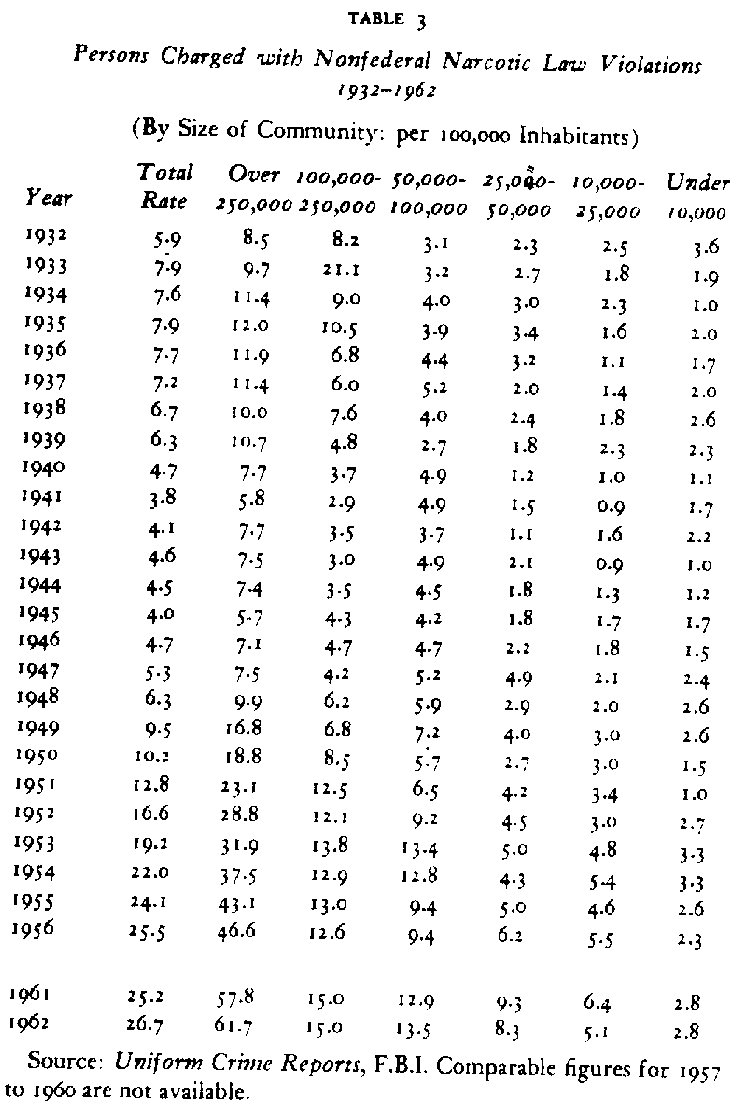
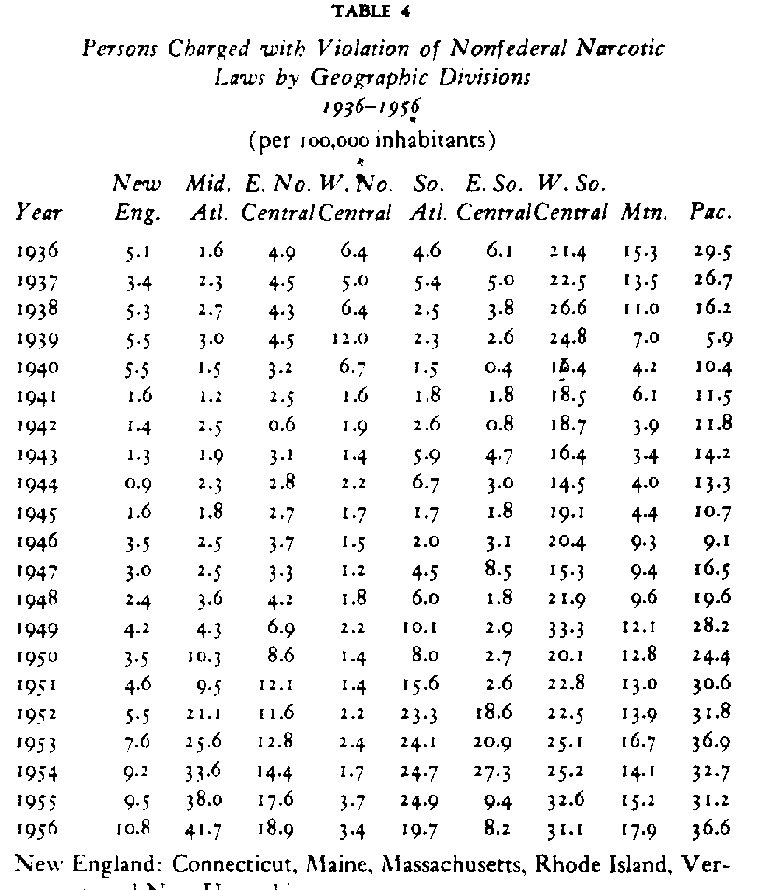
New England: Connecticut, Maine, Massachusetts, Rhode Island, Vermont, and New Hampshire
Middle Atlantic: New Jersev, New York, Pennsylvania
East North Central: Illinois, Indiana, Michigan, Ohio, Wisconsin
West North Central: Iowa, Kansas, Minnesota, Missouri, Nebraska, North Dakota, South Dakota
South Atlantic: Delaware, Florida, Georgia, Maryland, North Carolina, South Carolina, Virginia, West Virginia, District of Columbia East South Central: Alabama, Kentucky, Mississippi, Tennessee
West South Central: Arkansas, Louisiana, Oklahoma, Texas
Mountain: Arizona, Colorado, Idaho, Montana, Nevada, New Mexico, Utah, Wyoming
Pacific: California, Oregon, Washington
Source: Uniform Crime Reports, F.B.I. Comparable figures are not available after 1956,
It is especially interesting to observe, in connection with the alleged effectiveness of the 1951 legislation, that the overall arrest rate doubled from 1951 to 1956 and that arrest rates increased during this period in communities of all sizes and in all geographic divisions without a single exception. The concentration in large cities is especially marked and it will be noted that arrest rates are lowest in the West North Central states of Iowa, Kansas, Minnesota, Missouri, Nebraska, North and South Dakota. In only one region is there a definite tendency for the rates to decline after 1954 and this is the one which comprises Alabama. Kentucky, Mississippi, and Tennessee. It is possible that this reduction may be associated with change in policy at the Public Health Service Hospital for addicts in Lexington.
The Census Bureau’s survey of prisoners and of commitments to penal institutions in 192 3 permits us to supplement Table 4 by providing data concerning commitment rates by geographical divisions for drug offenses in 192 3. These were given as follows in the 1923 survey.11
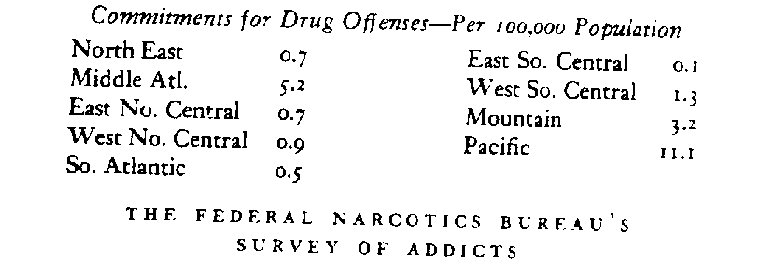
In 1953 the Federal Bureau of Narcotics began to make a count of drug addicts in the United States on the basis of reports sent in by, enforcement officials throughout the nation. It is impossible to form a very precise notion of how the survey is being conducted because the Bureau has never described the project in sufficient detail. Prepared addict-identification cards are evidently sent our to enforcement officials throughout the country and these officials are urged to fill out a card on every addict who comes to their attention and to mail the card to Washington for processing. In Washington the Federal Bureau of Narcotics checks the names on the cards that it receives against those it already has in order to eliminate duplication.
From 1953 to 1962 the Bureau has given the number of newly reported addicts each year: 12
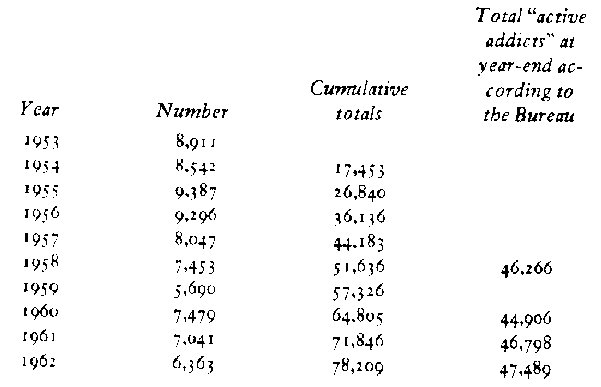
It will be noted from the above that while 79.000 addicts were counted during these ten years, 30.000 of these names were eliminated from the list h 1 96 2. This discrepancy between the reported number of “active addicts” and the actual count began in 1958, when the Bureau added a footnote to its tabulations explaining that “3,541 of the addicts reported in 1953 have remained active throughout the five years 1954-58.” Names of addicts are eliminated from the active list, apparently, when new reports are not sent in on them over a five-year period. An assumption underlying this procedure is that if an addict is using drugs he will be apprehended within five years. Hence, if the addict is not reported it is assumed that he is in prison, that he is dead, or that he has quit his habit-hence, that he is no longer an “active addict.”
The names received by the Bureau are sorted into two general categories which are labeled “recidivists” and “new addicts.” Both of these terms are misleading and ambiguous. One does not know, for example, whether an addict counted in 1953, and sent to prison for eight years, would be counted as a “new addict” or a “recidivist” if his name turned up again in 1961 long after it had been removed from the active list. Also, when the survey began in 1953 certainly there were many old-time addicts who must have appeared on the Bureau’s list as “new addicts” and there must surely be persons of this sort showing up each year. The fact that an individual is listed as a “new addict” in the survey therefore has no necessary relationship whatever to the duration of his addiction or to his age, and the Bureau’s annual totals of new addicts tell us nothing whatever about the rate at which people are becoming addicted.
Since the Bureau does not count incarcerated addicts as “active addicts” it would be important to know how many drug users are serving time in jails and prisons. No direct information on this point is available, but the Federal Bureau of Prisons does report that the number of drug law violators serving time in federal penal institutions in 1 960 was 4,794.13 A substantial proportion of these prisoners are known to be addicts. In addition there are addicts serving sentences in federal institutions for non narcotics offenses. Some indication of the number of addicts in state penal institutions may be derived from local figures such as those from New York, where the State Department of Correction had 3,249 former drug users in its institutions in 1956, comprising 20 per cent of the prison population. In 1956 2 3 per cent of the new admissions were drug addicts.
In the same year an additional 4,886 addicts were reportedly newly admitted to the correctional institutions of New York City alone.” In 1923, by, way of comparison, a complete census of Prisoners in 211 types of penal institutions in the United States indicated only 3,847 serving time for violations of drug laws.15 Obviously, the number of addicts in our penal institutions is very substantial and ought to be taken into consideration in any realistic estimate.
It would be expected on a purely mathematical basis as the Federal Narcotics Bureau’s enumeration goes on year after year that the number of newly reported addicts would decline as the enumeration became more complete. For example, in 1958, 14,899 names of addicts were actually reported to the Bureau.” Of these 7,446 had been previously reported, leaving only 7,453 so called “new addicts.” The 1953 total could not have been reduced in this manner because this was the first year of the survey and presumably most of those reported had to be “new” since they could have been reported previously only during the same year.
The point may be illustrated by a hypothetical example. Let us assume that a given community has exactly 10,000 addicts over a period of fifteen years and that a survey like the Bureau’s is made in that community over this fifteen year period. Let us suppose that after nine years 9,500 of these addicts had been counted, and the remaining 500 were enumerated during the tenth year. Obviously one could not conclude from the reduced number of “new addicts” during the tenth year that addiction in this community
had been reduced by fifty per cent any more than one could conclude that the absence of any new addicts in the eleventh and subsequent years meant that addiction had been eliminated. This, however, is the way in which the Bureau interprets its findings! 17
For example, as evidence of the effectiveness of the Narcotic Control Act of 1956, the Bureau refers to the following reductions in the number of newly reported addicts during eleven months of 1958 as compared with the whole year of 1956.18
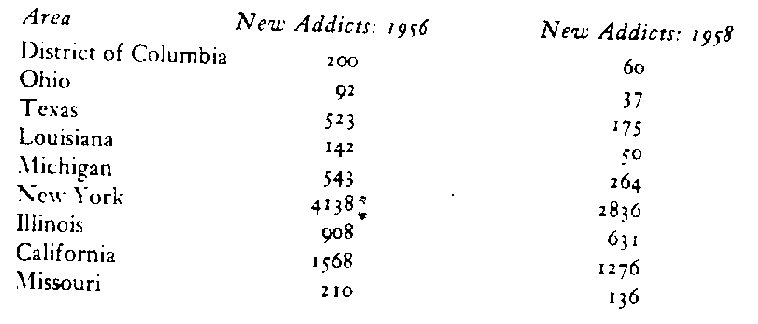
Apart from the fact that if the Bureau’s survey is worth anything at all the number of newly reported addicts should automatically decline, it is also obvious that the above illustrations presented by Mr. Anslinger were selected because they happened to show a decline and that contrary instances were ignored. Using the Bureau’s own figures and selecting states in the same biased manner
to present an opposite impression, the following instances may be cited to suggest a great increase in addiction from 1959 to 1960. 19
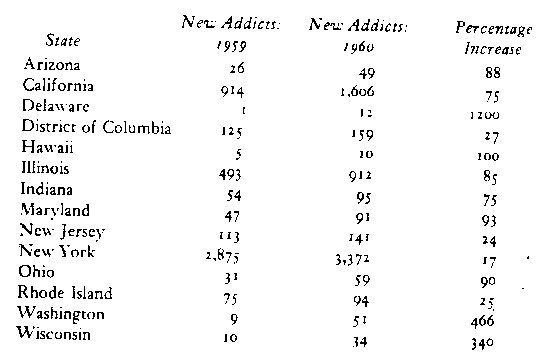
Henry L. Giordano, the new head of the Federal Bureau of Narcotics appointed in 1962, has continued the Bureau’s practice of comparing incomplete current enumerations with comprehensive estimates of the past in order to maintain the fiction that the problem is declining. In a news release from Washington on November 10 1963, for example, he is reported as saying that the number of addicts had declined from a recent high of 60,000 to 2 total of about 47,000 at the end of 1962. Special significance was attached to a decline in the number of new addicts from 9,337 in 1956 to 6,363 in 1962 Giordano makes the same points in an interview reported in January 1 964.21′ Although the figures cited by Giordano are worthless for the purpose for which he uses them, and although this is recognized by all competent students who have examined them, they are nevertheless popularly accepted because the Bureau is in a position to repeat them endlessly in the mass media.
A comparison of the Bureau’s survey as it applies to California with the results of a survey being made by the state of California is illuminating. Thus the Bureau gives the total of California addicts as 7,412 at the end of ten years of counting. The state of California, on the other hand, after only three and one-half years of its survey, has a list of 13,520 in December 1962 and estimates the total at about 20,000 (illegal addicts).21 During the last four years the Bureau reported the following new addicts from California: in 1959 – 914; 1960 – 606; 1961 -1220; 1962-902. The state’s survey reported about 7,400 new addicts in a year and a half ending in December 1960 about 3,500 in 1961, and about 2,500 in 1962. At the end of 1 960 there were, according to the Bureau of Narcotics, 741 1 active addicts in California. During the next two years 2, 1 2 2 new addicts were discovered but the total was increased by only a single addict!
There are many other unexplained inconsistencies and discrepancies in the figures which the Bureau of Narcotics publishes. For example, between 1953 and 1959 three new addicts were reported from Utah and the number of “active addicts” at the end of 1959 was given as one. Nevertheless, during the same years the Bureau’s figures show 117 arrests and 101 convictions for
narcotics offenses in that State. 22 If the 101 convictions involved non addicted peddlers, one wonders how they were managing to dispose of their wares.
The Bureau’s survey is necessarily conducted on a voluntary basis, but no information has been published to indicate exactly
how much cooperation has been elicited. There is no way of knowing how many agencies do not report or of evaluating the reporting that is done. W. B. Eldridge worked relatively closely with the Bureau in an attempt to discover the information that is absolutely necessary for a statistical evaluation of the project. He was unable to obtain it. He reports that no uniform standards or instructions appear to have been given to reporting agencies and that there is a great deal of confusion about what is supposed to be done.23 When one remembers that the Federal Bureau of Investigation, after more than thirty years of effort, still has formidable unsolved problems in producing reliable and complete crime statistics, it would be surprising indeed if the Narcotics Bureau’s survey were anything but extremely incomplete and unreliable.
If the Bureau had complete cooperation from all possible reporting agencies so that data would be sent to Washington on every addict coming to official attention, and if the names of addicts were dropped from the list only when they were known to be dead, then, after a period of years, the total count would have some real significance in estimating the extent of the problem. Under such circumstances of full reporting, one would expect that the annual totals of newly reported addicts might become relatively stabilized and that it might be possible to make some inferences concerning the number of new addicts being created each year. In 1958 the Bureau of Narcotics published data on the total number of addicts reported during the year which indicated that very close
to 50 per cent were “new addicts.” In a relatively complete survey one would expect that most addicts coming to officials’ attention would already have been counted and that the proportion of new addicts would be considerably – less than fifty per cent. In 1958 the proportion of new addicts was under fifty per cent in only four states and in the District of Columbia.
If one takes seriously the Bureau’s assumption that the number of new addicts it reports represents the rate at which addicts are being created, one has other problems. Thus during the decade beginning in 1953 there were reported 78,209 “new addicts.” Since the Bureau says there were about 60,000 addicts in the United States at the end of 1952 we would have a total of 138,000 addicts to account for. If there were only 47,000 left in December 1962, what happened to the other 91,000 during these ten years?
An analysis of the Narcotics Bureau’s survey of addiction suggests that this enterprise may well be a public relations effort rather
than a serious attempt at enumeration. Detailed descriptions of the methods employed have probably not been published because it is realized that they would not stand inspection. The indicated remedy is that the business of counting addicts should be turned over to the more expert, reliable and experienced statistical services of the Federal Bureau of Investigation. It would be a relatively simple matter for this agency to extend its present reporting functions to include an annual count of addicts arrested for all offenses.
An article published in December 1948 by three Public Health Service officials at Lexington provides an illustration of the manner
in which Bureau figures have misled experts as well as laymen. The article opens with the following statement:
When the Harrison Narcotic Act was passed in 1914 there were perhaps 150,000 to 200,000 narcotic addicts, mostly women. in the United States. Now, according to a recent estimate by Mr. H. J. Anslinger, Commissioner of Narcotics, there is about 1 addict per 3,000 Of population, or a total of approximately 48,000, mostly men. This reduction has been largely due to the vigorous enforcement of the Harrison Narcotic Act and to Federal facilities for the treatment of addicts. Compared with the problems arising from the abuse of drugs such as barbiturates and alcohol, narcotic addiction is not a great public health hazard.24
This article was hailed by the press throughout the nation as an authoritative indication that the problem of drug addiction had been laid to rest. A Chicago newspaper headlined it: “Find Narcotics Beaten as U.S. Health Menace.” Within less than two years the authors of this article were being besieged by an aroused public to explain the increased prevalence of youthful addicts. A glance at the tables presented in this chapter will indicate that the postwar increase in addiction -was already well under way in 1948 when this article appeared. The 1948 total of nonfederal prosecutions, for example, -,vas about 400 per cent higher than the 194 2 total and the proportion of offenders under 25 years of age had increased from 17 per cent to 40 per cent.
The conclusions which emerge from this discussion are: that the number of addicts in the United States in 1914 is unknown and cannot be reliably estimated; that it is even more hazardous to estimate the extent of the problem today; and that federal narcotics officials have, over a long period of years, underreported and underestimated the problem.
THE AVERAGE AGE OF ADDICTS
It is worth noting that in the only national statistical reports on narcotics offenders in which age is given, those in the Uniform Crime Reports, the percentage of young persons increased progressively for two decades after 1932, when this data first began to be published. Thus in 1932, 15 per cent of the offenders were under twenty-five and 3-3 per cent under twenty-one years of age, whereas in 1961 41.7 per cent were under twenty-five and 19- 5 per cent under twenty-one. It is practically impossible in view of what is known of addicts that their average age should decline while their numbers diminish. Since the decline in the average age of narcotics offenders. most of whom are addicts, appears in the figures between 1932 and our entry into the war in 1941, it seems possible that the number of addicts in the country may also have been increasing then. During this period the percentage under twenty -five increased from 1 per cent to 2 7 per cent and the percentage under twenty-one from 1.3 per cent to 10.1 per cent. Recent slight declines in the proportion of young persons have tended to increase the average age, but this effect has been produced more by an increased number of older addicts than by a decline in the number of young ones-in short. by the fact that the relatively large numbers of addicts in their late teens and early twenties during the 1945-55 period are now usually past the age of twenty five years.
In 1923. when, according to the Narcotics Bureau’s chart, there were about 180,000 drug addicts in this country, the Census Bureau made a virtually complete survey of all prisoners in penal establishments of all types in the United States and of all commitments to these establishments for the first half of the year. The survey covered state and federal prisons and reformatories, state farms, municipal and county jails, and work-houses and chain gangs. The average age at that time of the persons committed for violation of the drug laws was approximately thirty-one years .25 The average age of known drug law offenders today is probabIy about twenty-six or twenty-seven.
Because the rate at which addicts quit the habit is low, and because the abstaining addict is always subject to relapse, it makes a great deal of sense to think of the addict population as one which is effectively reduced only, or at least mainly, by death. It is possible for the number of addicts to increase rapidly, as it seems to have done after the late war, but it can scarcely decline rapidly, since we may reasonably assume that the mortality rates of drug users do not change abruptly. This means that any claim of an unusually drastic decline in the number of addicts is highly suspect. It also means that the relatively sudden appearance of ‘man y new drug users among Young persons will be noticed for many years to come.
Since addiction in the United States is usually acquired relatively early in life, an effective control program would have the long-run effect of gradual] y increasing the average age of known addicts. Actually no such trend is observable in the statistics of the drug problem in this country and has never been, as has been pointed out, except possibly for brief periods. Only if at some future time it should be noted that over a period of twenty years, for example, the average age of known addicts had increased, say from 25 Years to 30 or more would it be justifiable to conclude that the problem it as being effectively dealt with and that the stream of
new recruits had been checked.
Studies made before 1915 indicate that addicts were considerably older than they now are and that the habit was acquired later in life, For example, C. H. Earle in 1880 reported the average age of a sample group as 39-7 and described the habit as a “vice of middle life.” J. M. Hull, in 1885 found the average at age of a series Of 235 cases to be 46-5. A more extensive study was made by L. P. Brown of addicts who were registered and rationed for a brief period immediately preceding the enactment of the Harrison Act in the state of Tennessee. The average age on January 1, 1915. Of the 2,370 registered addicts was So years and average age on acquiring the habit was given as 3 7.21
CRIME AND ADDICTION IN THE U.S. AND ABROAD
With a population as large as that of the United States, even if one assumes that there are 150,000 to 200,000 addicts, these are not large numbers; but if we compare ourselves with other nations they are enormous. The Senate subcommittee under Price Daniel, which accepted the 60,000 estimate from Mr. Anslinger, nevertheless noted that there were evidently more drug users in this country than in all the rest of the Western world combined. Most European countries, for example, estimate between 300 and Soo addicts.27 Germany, with the most severe problem of any European country before the war, placed hit total considerably under I 10,000 Britain, with a population roughly one-third that of the United Stares, estimates fewer than 1,000 medical and nonmedical addicts, In the four years from 1946 to 1949 inclusive the French police reported the detection of 687 addicts, only one of whom was under the age of 20 years, with a median age between 35 and 40. In Canada, where the problem is relatively severe and handled about the same as in the United States, the number of addicts is unreliably estimated at between 3,000 and 4,000. One must go to Asia to find countries which have drug problems comparable in size to our own.
The number of addicts in a community or a nation is not the only or the most important measure of the problem. For example, if in two communities of equal size each with a thousand drug addicts, the addicts in one community are non criminals medically supplied, while those in the second community are criminals purchasing illicit drugs on an illicit market and committing crimes to get money to buy expensive illicit drugs, the second community has a serious problem and the other a relatively minor one. In most of the countries of the West, except Canada and the United States, addicts are supplied from medical sources, so that, besides being fewer in number they are also less criminal than our own. In these countries the illicit traffic does not constitute a significant source of income for racketeering criminals nor does it make drugs of addiction sufficiently available and attractive to spread the habit among Young persons, for almost all addicts in these countries are adults. The United States not only has more addicts than the rest of the Western world, but considered man for man American addicts constitute much more serious social liabilities than do those of Europe.
Let us consider for a moment that it is commonly thought that there are at least 10,000 addicts in the city of Chicago maintaining their habits with illicit supplies. If we assume that each of these addicts commits one property offense per day this would mean a total of 3,650,000 crimes per year. Such an army Of 10,000 active criminals at large in a City Of 4,000,000 is a factor of some importance and may have something to do with the wariness with which the inhabitants of that city walk the streets at night. Again, if we assume that each of Chicago’s addicts spends $ 1 0 per day on drugs, this amounts to $36,500,000 per year paid into the hands of criminals, largely as tax-exempt income. This facet of the narcotics problem alone, though not as visible as others, is certainly one of its greatest evils.
Some brief numerical comparisons between the United States and some other countries that handle addiction as a medical problem will make the point we are concerned with. From official reports of the governments of Austria, Australia, Argentina, Belgium, Britain, Denmark, France, West Germany, Italy, New Zealand, and Switzerland the estimated total number of addicts in these eleven countries, with a combined population of about 250,000,000 is in the vicinity of 10,000 i.e., nearly the same total as that commonly given for Chicago with a 4,000,000 population.28 In the eleven countries listed above about 700 persons were prosecuted in 1956 for violations of narcotic laws. In 1954 the Chicago Police Department reported that it processed through its narcotics bureau 7,639 narcotic offenders. Thus, in proportion to population Chicago seems to have, on the basis of these figures, about 60 times as many addicts as the above eleven foreign countries and about 600 times as many narcotics prosecutions. The penalties imposed upon narcotics violators in the eleven foreign countries almost always involved maximum fines of less than $400 and jail sentences of less than one year, with most offenders being fined. The number of addicts below the age of 20 or 21 Years among the known addicts of these nations was reported as less than twenty-five,
In all probability the above numerical comparisons understate the difference between our narcotics problem and that of the foreign nations named. As pointed out earlier in this chapter, United States statistics on narcotics are grossly unreliable and tend to understate the problem, In countries in which addiction is not a criminal matter, reliable statistical data are relatively easily obtained from official records kept by drugstores and doctors. In addition to having more accurate statistics, many of the countries named include medical addicts in their totals. In some of the countries the addicts consist to a substantial extent of persons who are receiving narcotics in connection with disease and chronic pain, and of addicted doctors, nurses and pharmacists. Such addicts are not ordinarily included in American estimates. The Chicago estimate, for example, does not include them. West Germany in 1960 reported to the United Nations that Of 4,334 registered addicts, 863 were connected with the medical and ancillary professions, 470 were war invalids and disabled pensioners, and that in 3,102 cases the addiction was therapeutic in origin. This suggests that if the American system of counting addicts were applied to Germany the total would be much lower than the one cited above.
During hearings before congressional subcommittees studying the drug problem it was frequently estimated by police officers from various large cities of the United States that nearly half of the crimes in their communities were linked with drug addiction, One may well be inclined to regard this as gross exaggeration, since official crime statistics certainly do not support it, but if one considers actual crimes committed rather than merely those that happen to find their way into the official statistics, and if one considers that, unlike other criminals, addicts necessarily violate the criminal law many times daily, then the conclusion does not seem so absurd. The importance of addicts in crime is far out of proportion to their numbers, but in the nature of the case no reliable figures are available upon which definite estimates can be made.
Needless to say, the American addict is ordinarily impoverished, degraded, and demoralized. This fact, and its repercussions upon the families and relatives of addicts, is part of the human cost of the narcotics problem. In this respect the United States again leads the Western world, for nowhere else are addicts as impoverished, degraded, and demoralized as they are here.
If we disregard the question of numbers and focus our attention exclusively on those evils connected with addiction which are the result of the way in which the problem is dealt with rather than the necessary consequences Of addiction itself, then we may say that the drug problem of today is largely one that has come into being since 1914 when the Harrison Act was passed and largely because of it. Before 1915 addiction was a problem mainly in 2 numerical and personal sense; today it has become in addition a substantial social problem. Before 1915 there was no significant illicit traffic, criminality and addiction were not linked as they are now, the number of addicts in jails and prisons was negligible, and there was no problem of juvenile addiction. It should also be remembered that the vast majority of all present-day drug users became addicted after the Harrison Act was passed.
RECRUITMENT OF NEW ADDICTS
There are two main ways in which addicts are added to the ranks: (a) one is through the therapeutic use of the drug either because of a doctor’s prescription or because of folk belief and popular custom; (b) the other is through association between addicts and non addicts with the drug being used for other than therapeutic purposes, Each of these patterns of recruitment tends to select different kinds of persons. Which of the patterns dominates seems to be determined mainly by the kind of control policy in effect. When the policy is one of prohibition and punishment for addicts, the second pattern is ordinarily dominant and the number of addicts relatively large; when addicts are handled as patients and are given access to legal drugs, the number of addicts tends to be smaller and most of them have first used drugs for medical reasons.
From a knowledge of the demographic characteristics of a nation’s addicts it is usually a simple matter to infer what that nation’s policies are, and vice versa. Thus if there are relatively many addicts and they are overwhelmingly young urban males from the lower classes and the slums, one may infer that the control system is one of prohibition and punishment, as in the United States, and that the habit is being spread through underworld association between addicts and nonaddicts. On the other hand, when the addicts are older, so that few are under thirty, for example, and when they are rather evenly distributed by classes, by sex, And in rural and urban communities, one may usually conclude with confidence that addicts are handled as medical cases and are recruited primarily through the therapeutic use of drugs. In this case it is also usually true that the number of addicts in proportion to population is comparatively low and that addicts from the medical and allied professions constitute a large percentage of the total. In 1960, to cite two examples, Britain reported that 63 Of 437 addicts were connected with the medical profession and West Germany that more than 8 50 *Of 4,3 34 in that country were so connected.29
Medical recruitment accounted for the largest proportion of new addicts in the United States during the nineteenth century. as it also does today, in most European countries where addicts are supplied with drugs by doctors. During the nineteenth century in the United States the spread of addiction was largely determined and decisively influenced by conditions and developments within the field of medicine. Among these influences were the discovery of morphine near the beginning of the century and of heroin near its close. Both of these drugs were at first believed not to be habit forming and were liberally and carelessly used by physicians. During the Civil War, the hypodermic method of injection came to be Widely known and it was at first thought that opiates administered in this way were not habit-forming. Opium and its derivatives played a much larger role in medical therapy in those days than now and were used in the treatment of a great many ailments. They were, for example, extensively used during the Civil War in the treatment of dysentery, which was so common in the Army that it was sometimes called “the soldier’s disease.”
A factor of special importance in the spread of the drug habit during the nineteenth century in this country was the extraordinary dimensions of the patent medicine industry. Many of the nostrums sold during the parent medicine era in large quantities contained opium or addicting drugs derived from it. The sale of these medicines was largely uncontrolled and the persons who
bought them rarely knew what the contained. As the drug habit spread and became a matter of personal concern to more and more people, the patent medicine industry rose to the occasion with many medicines which were guaranteed to cure addiction. Most of these remedies themselves contained the addicting drug so that the patient simply transferred his addiction to the remedy. When heroin first appeared, it was sometimes used by physicians to cure the morphine habit.
There was little or no regulation of the distribution of addicting drugs in any of the countries of the Western world during this period, but in the older, more mature countries of Europe, medical practice was more sophisticated and more closely regulated and the consumption of drugs in patent medicines and other forms did not develop as it did here. The per capita consumption of drugs in this country, as shown by the quantities imported, rose rapidly throughout the nineteenth century until about 1900, when it began to decline. The reasons for the decline were that control measures had begun to be enacted on a local basis, medical practice had become more sophisticated, and the public had become more aware of the danger of addiction. The Pure Food and Drugs Act of 1906 put a crimp in the patent medicine industry and in 1909 the importation of smoking opium was forbidden by congressional action.
In the years immediately preceding the Harrison Act various types of control measures were enacted by different states. As a consequence of these early measures small numbers of narcotics offenders and addicts began to show up in )ails and prisons and studies were made of them. Invariably these studies revealed the characteristic pattern of underworld recruitment by association, such as youth, criminality, slum origins, and a large preponderance of males. During the same period and before, studies of those addicts receiving drugs from legal. sources usually showed an approximately three to two preponderance of females, a high average age, and an even distribution among the socioeconomic classes.,'”
The smuggling and illicit use of drugs, which began in a small way before 1914, went into high gear when the Harrison Act was passed. The effect of this Act may be indicated by noting that the Census Bureau reported a 2066 per cent increase in the number of narcotics violators committed to all types of penal institutions in 192 3 as compared with 19 1 10 In 19 1 the total of such commitments was given as 314.31
The Harrison Act had the effect, along with other measures, of drastically reducing the flow of new addicts from medical practice
or through the use of legal drugs On the other hand, by shutting off the supply of legal drugs for the countless users without criminal records it forced them to the illicit traffic and into the underworld. The illicit traffic expanded enormously and there was a large increase in the rate at which new addicts appeared within the underworld. The appearance of large numbers of the new type of
addict, recruited from the underworld and its fringes and from a younger urban generation, was observed and commented upon as
early as 192 1 by E. S. Bishop. They were motivated by “curiosity” and “search for adventure,” he said, and stimulated by “unfortunate spectacular publicity.”32 At present, more than forty-five years after the Harrison Act, the trends set in motion by it have had time to work themselves out, The old type of addict who first used drugs in connection with illness or by smoking opium has now been replaced by another type of user who takes up heroin looking for kicks and who is evidently attracted to it in the first place by the glamor of its illegality and expensiveness.
An outstanding feature of the changing nature of the addicted population has been the spectacular increase of addiction among Negroes, particularly in northern cities. Before 1915, surveys generally indicated that there were few Negro addicts and that the Negro population as a whole, in proportion to numbers, had about as man%- or somewhat fewer addicts than the white.33 Since that time the proportion of Negroes among narcotics law violators has increased to around half of the reported national totals. This trend has been especially pronounced in some northern cities, where arrest rates of young Negro males for narcotics offenses have in some instances increased by several thousand per cent in a period of twenty years.
Whatever other factors may be involved, it is clear that it is the illicit traffic which makes the drug available to Negroes in the slums, and also supplies an easy but dangerous way of raising the money with which to buy it. Increased addiction among Negroes cannot be accounted for in racial terms, since the trend appeared only after the Harrison Act was passed, and then primarily among urban Negroes in the North. Two other minority groups which have become involved in recent years are Puerto Ricans and
Mexicans.
Another minority group which formerly contributed disproportionately large numbers of narcotics law violators was the Chinese. It was the Chinese who came to this country in the second half of the nineteenth century who introduced opium smoking to America. The habit was picked up from them by American criminals, among whom it became something of a fad. Opium smoking
thus became the first natural target of control measures. The Chinese, who imported the opium, smoked it, and operated the early opium joints, constituted a considerable proportion of the offenders against the anti opium measures of the late nineteenth and early twentieth century. When the traffic became big business after 1914 it passed out of Chinese hands. As the years have passed the Chinese contribution to the problem has steadily diminished. In 1957 only 13 persons of Chinese origin were reported in 2 total of more than 7,000 offenders.
It is a common belief that addiction is deliberately spread by drug pushers to enlarge their markers and that they give away free samples to non addicts to get them hooked. This idea is false. If instances of this sort do occur they are very infrequent. Peddlers do not give drugs away because they are too expensive and because it is too dangerous. If an ambitious entrepreneur were to start giving away free samples in the manner depicted by some writers, word of this would flash through the addict community and he would be besieged by willing victims, most of them addicts claiming never to have touched heroin in their lives. A considerable number of addicts have testified before congressional committees and most were asked how they became addicted. None of them said it had been through free samples distributed by a pusher. although most did say that their first shots were obtained -without cost from friends. Some of the confusion and controversy on this question arises from the tendency of addicts to blame other persons for their addiction when they think they can get by with it or when there is some advantage to be gained by it as, for example, in court before an unsophisticated judge or jury.
As I have said, the process of initiation into the drug habit today usually presupposes intimate friendly relationships between a user and a nonuser, such as those between lovers, close friends. or gang members. The nonuser is not forced to take his first shots or even ordinarily urged to do so. He does so of his own volition often against the advice of his friends. The human relationship in which addiction is established and in which the preliminary psychological preparations for becoming addicted take place are of such a nature that they are rarely observed. Ordinarily we learn about them only afterward when a new addict is discovered. One of the most favorable environments for the spread of the drug habit in addition to the city slum is, paradoxically, the jail or prison. Unprecedented numbers of addicts are now to be found in our penal institutions. Non addicted prisoners become acquainted with them and listen to them talk about dope. Curiosity is aroused. When drugs are successfully. smuggled in they may try a pop, or they may. do so after release when they meet their addicted prison pals. Non addicted criminals often despise and distrust addicts but such prejudices tend to break down in the intimacy of prison life.
Another important element in the creation of new addicts is the lure of easy money from the traffic. Persons who go after a fast buck in this way sometimes end up using the product which they, sell. The traffic brings them into association with addicts. familiarizes them with the lore and the necessary techniques, and arouses their curiosity. The step to actual experimentation is easy, especially so because like most non addicts the beginner usually believes that he has sufficient will power to resist the drug or to dram, back in time.
Introduction | 1 | 2 | 3 | 4 | 5 | 6 | 7 | 8 | 9 | 10
notes
1. Commission on Narcotic Drugs, U.N. Economic & Social Council, Suntmary of Annual Reports of Governments relating to Opium and other Dangerous Drugs (New York: U.N. Publications, ig6i), p. 34.
2. Daniel Subcommittee Hearings, Part 8, PP. 3926-27
3. California State Narcotic Committee, The Trend of Drug Addiction in California (Sacramento: California State Printing Office, 193 1), p. 16.
4- See Daniel Subco??tmittee Hearings, Part 8, PP. 3775-76, for description by a Calif omia official.
5. Bureau of Criminal Statistics, State Department of justice, Summary, Narcotic Statistics for California, 1954-~9; Narcotic Arrests in California, July 1, 1959-June 30, ig6o; and Narcotic Arrests and Dispositions in California, ig6i. The report for 1962 follows the 1961 f ormat.
6. H. J. Anslinger and W. F. Tompkins, The Traffic in Narcotics, p. 265
7. Lawrence Kolb and A. G. Du Mez, “The Prevalence and Trend of Drug Addiction in the United States and Factors Influencing It,” fublic Health Re orts, 39, No. z i (MaV 2 3. 1924), S. (Originally found on pp. , T
1179-1204; reprint copies are paged from I to 26.)
– – 8. Daniel Subcommittee Hearings, June 2. 3, 8, 195 5, PP. 9 10.
, 9. Lawrence Kolb and A. G. Du Mez, “The Prevalence and Trend of Drug Addiction.”
jo. Ibid., P. 20.
i i. Bureau of the Census, Department of Commerce, Prisoners, z923:
Crime Conditions in the United States as Reflected in Census Statistics of Imprisoned Offenders (Washington, D.C., iqz6), P. 41
x 2. The figures that follow are from the annual reports of the Bureau of Narcotics, Traffic in Opium and Other Dangerous Drugs.
13. Federal Prisons, ig6o, P- 38.
14. Second Interim Report of the State of New York joint Legislative Cormnittee on Narcotic Study (Legislative – Document No. 0, 1958), P. 28.
15. Prisoners, 1923, P- 31.
16. See the Bureau’s annual report, 1958, p- 45.
17. Cf. the Bureau’s annual report, 1962, P- 57, and the statement by the present head of the Bureau in Pete Martin, “What Hope for Nar~ cotics Control? An Interview with Henry L. Giordano, Commissioner of the Bureau of Narcotics,” The American Legion Magazine, 76, No. i (Jan., 1964), 37.
18. Comments on Narcotic Drugs, pp. 175-85. The comparisons are emphasized by graphic representation.
ig. The figures are from the Bureau’s annual reports.
2o. Pete Martin, “What Hope for Narcotics Control?” P- 3 7.
2 x. Narcotic Arrests and Dispositions in California, 196 1, P. 3 1, and the 1962 report, P. 36.
22. W. B. Eldridge, Narcotics and the Law, P- 76.
23. Ibid-, PP- 68-80.
24. Victor H. Vogel, Harris Isbell, and Kenneth W. Chapman, “Present Status of Narcotic Addiction,” Journal of the American Medical Association, 138 (Dec. 4, 1948), ioig-26. Reproduced in Daniel Subcommittee Hearings, Part 5, pp. 1992-2014.
25- Prisoners, 1923, PP. 81, 274.
z6. The above are cited in C. E. Terry and M. Pellens, The Opium Problem, PP- 475-76.
27. The references to estimates Of addicts in foreign nations that follow in this chapter are obtained from the annual U.N. publication by the Commission on Narcotic Drugs, Summary of Annual Reports of Governments.
t8. U.N. Summary, especially for 1956 and 1958
zq. Ibid., 1960, PP- 36, 39
30- Cf. C. E. Terry and M. Pellens, The Opium Problem, chapters 1, 11, and VIII.
3 1 . Prisoners, 1923, P. 3 1.
3 z. Ernest S. Bishop, The Narcotic Drug Problem (New York: Mac
Milian, 192.0, pp. 125-26- Cf. C. E. Terry and M. Pellens, The Opium Problem, P. 482.
33- C. E. Terry and M. Pellens, The opium Problem, pp. 25,28
Introduction | 1 | 2 | 3 | 4 | 5 | 6 | 7 | 8 | 9 | 10
|






 Button Ads!
Button Ads! 
















